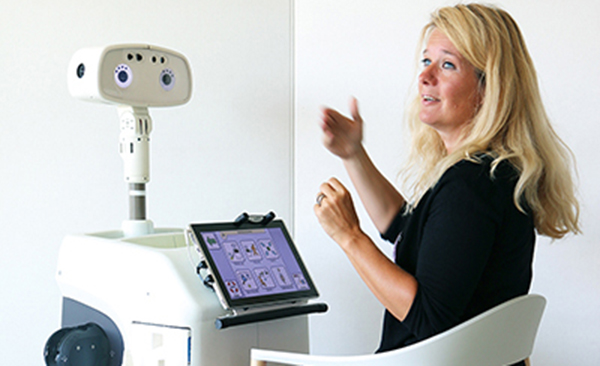Robots are developed based on an erroneous view of elderly user
Our increasingly aging population makes it necessary to find new ways to work with home care, and robotics can be one of them, argues Susanne Frennert, who recently defended her thesis in rehabilitation engineering at the Department of Design Sciences at the Lund University Faculty of Engineering (LTH). She has studied what happens in the everyday lives of elderly people when robots move in, and one of the insights she has gained is that robots for the elderly are often developed based on a distorted view of who they are and what they need.
Susanne Frennert, recent PhD graduate and researcher at the Department of Design Sciences at LTH, believes that robots will increasingly become a natural feature in future homes – both physical robots and robots like Siri on your phone. She predicts that if users are involved already in the design process, the robots can become a great addition to human support in future home care for the elderly.
Through her research, Susanne Frennert has found that elderly people are much more picky than robot manufacturers seem to think.
“Elderly people want to know what robot technology can do for them and are not interested in having a support robot in their homes if it does contribute in a useful way”, says Susanne Frennert, who argues that many manufacturers have a view of the elderly as passive recipients, and that this stereotype determines the development of the robots.
Hobbit the robot is to act as support, a communication tool and companion for the elderly. For three weeks at a time, the Hobbit lived with the elderly users while Susanne Frennert studied their interaction. It became clear that the robot was more often used as entertainment than for practical support. The Hobbit also proved to be a bit clunky and had difficulty navigating in a normal home with lots of furniture, loose objects, and visitors.
“In everyday life, furniture gets moved around and grandchildren come to visit. The digital maps, which the robot uses to navigate, are then no longer correct, and it may be difficult for it to pick up things from the floor or alert the emergency services if someone has fallen down”, says Susanne Frennert.
” You have to look at the robot in the right context.”
Previous studies of robots have been conducted outside the context for which the robots were intended. They have been tested by users in lab environments, as opposed to in real-life situations. Inside people’s homes there are furniture, doorsteps, carpets, light reflections from lamps and a lot of activities which, according to Susanne Frennert, developers rarely take into account in the lab.
“You have to look at the robot in the right context. It has to fit into the physical environment, the technical environment and in social settings.”
Future robots must adapt to humans and their respective contexts, and not vice versa, argues Susanne Frennert.
“The robots should have more artificial intelligence and learn to understand human patterns, as well as when and when not to interfere. It is not always appropriate for the robot to remind a person that it is time for them to take their medicine. If they have visitors at the time, they perhaps do not want to be disturbed. The robot’s timing must simply work.”
In her studies, Susanne Frennert has received many suggestions from elderly users on how future robotics can be developed specifically for them. Some say that if the robot could help them sort the massive flow of information that surrounds them it would make their everyday lives easier, while others want help cleaning and to receive reminders that it is time for them to get some exercise.
“Unfortunately, many of the robots developed for the elderly today reflect attitudes, views and norms of elderly people as more ill and more feebleminded, and less mobile than the majority of them actually are. By drawing on their vitality, life experience and wisdom in the development of robots, the technology could become truly useful for the target group in the future”, says Susanne Frennert.
Text: Jessika Sellergren
Facts
-
Hobbit
-
Hobbit the robot was developed within an EU project between the Department of Design Sciences at LTH and TU Wien, Vienna. The aim of the project is to enable elderly people to stay longer in their own homes, and the results of the research studies will be the basis for further development of the robot.






